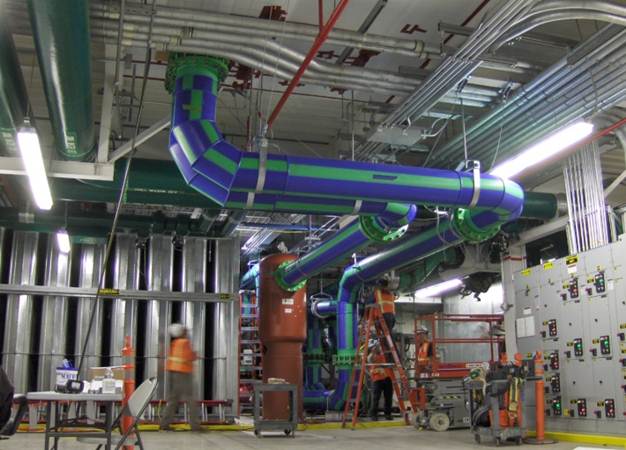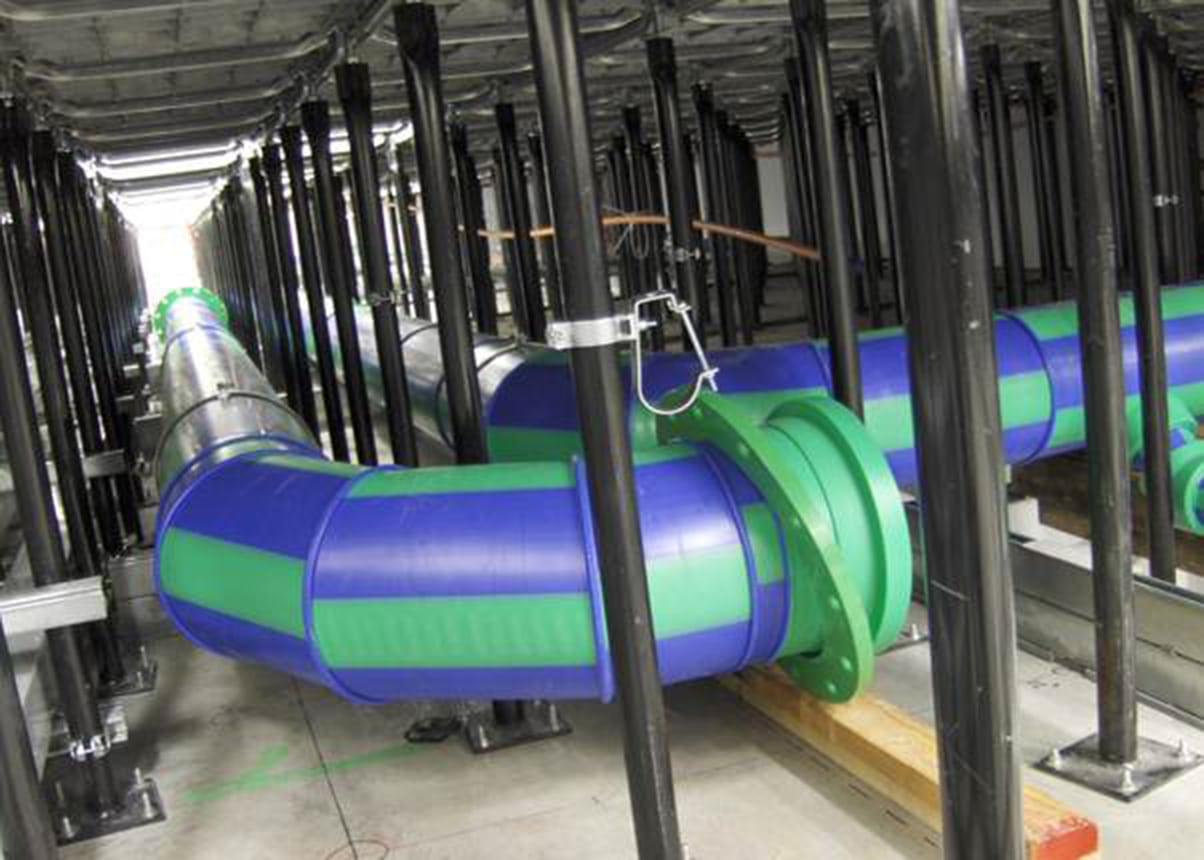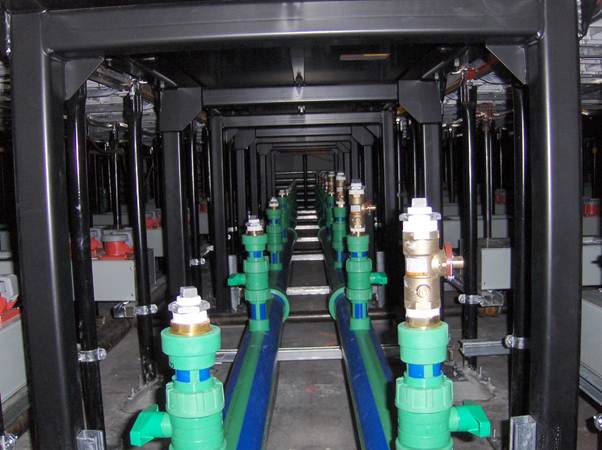THE FOLLOW-UP FILES: SUPERCOMPUTERS STAY COOL WITH AQUATHERM
Lawrence Livermore National Laboratory selected aquatherm in 2012 and again in 2018 for ‘mission supercritical’ cooling of some of the world's fastest supercomputers
The Challenge
Providing a piping system that would help provide trouble-free cooling to several of the world's most powerful supercomputers.
The Solution
In 2018 as in 2012, aquatherm’s PP-R pipe offered all of the benefits of plastic (cost savings, easier installation, improved flow) without any fumes, glues or chemicals used during installation.

The light weight of aquatherm pipe made it much easier to install than steel or copper pipe at Lawrence Livermore National Laboratory.
Supercomputers are hard at work 24/7 in vital areas such as defense, weather forecasting, satellite monitoring, and research, and the Lawrence Livermore National Laboratory (LLNL) in Livermore, CA is the home to some of the most powerful supercomputers on the planet.
The “Sequoia” supercomputer at the LLNL is a 20 petaFLOP/s (quadrillion floating operations per second) system that was ranked the world’s fastest supercomputer in June 2012. It was constructed by IBM for the National Nuclear Security Administration (NNSA) as part of the Advanced Simulation and Computing (ASC) program. It was delivered to LLNL in 2011 and fully deployed in June 2012. The system supports two missions: quantifying the uncertainties in numerical simulations of nuclear weapons performance, and performing the advanced weapons science calculations needed to develop accurate physics-based models for weapons codes.

Large diameter aquatherm pipe in place as part of the cooling system for the supercomputers at Lawrence Livermore National Laboratory.
In 2012, LLNL installed aquatherm blue® as part of the cooling system for the Sequoia. The performance of aquatherm pipe with Sequoia and other supercomputers led the lab in 2018 to again choose aquatherm for cooling its new “Sierra” computer, which is even faster and more powerful.
MEETING STRICT STANDARDS
The computer manufacturer had established strict water treatment and water quality requirements for the cooling system, and aquatherm’s chemical inertness played a key role in meeting that requirement.
Thanks to the chemical purity of aquatherm pipe, the system was not exposed to any foreign oil or material from the pipe. If steel had been used, the cooling water would not have met the specification due to oil residue. Also, had PVC been used, there was concern that potential glue overflow could have clogged the computer coil.
“By using polypropylene, we didn’t introduce metals into the system, and it also let us meet our ISO 14001 goals since there are a lot less chemicals in the system,” said Anna Maria Bailey, Livermore Computing Program Facility Engineer. “It’s easier to maintain and there isn’t waste that comes from treating the system with chemicals.”
THE BENEFITS OF HEAT FUSION
aquatherm’s PP piping systems are connected via heat fusion, which is a big factor in its reliability. Heat fusion bonds both sides of a joint into a single, homogenous material without the use of chemicals or mechanical connections, eliminating systemic weaknesses and fail points in the pipe. That is particularly important in mission critical applications such as supercomputing.
“We liked the heat fusion connections because there’s no welding. You can make the fusion bonds in the same space as the computers,” said Bailey. She added that LLNL purchased a heat fusion machine to enable it to install PP pipe in other facilities.
SIERRA TAKES SUPERCOMPUTING TO THE NEXT LEVEL
Sierra, Livermore’s latest advanced technology high performance computing system, joined LLNL’s lineup of supercomputers in 2018. According to LLNL, the new system provides computational resources that are essential for nuclear weapon scientists to fulfill the NNSA’s stockpile stewardship mission through simulation in lieu of underground testing. ASC program scientists and engineers use Sierra to assess the performance of nuclear weapon systems as well as nuclear weapon science and engineering calculations. This work on Sierra has important implications for other global and national challenges such as nonproliferation and counterterrorism.

aquatherm’s clean heat fusion process (below) and long life make it an ideal choice for mission-critical cooling applications such as data centers.
The IBM-built Sierra supercomputer provides four to six times the sustained performance and five to seven times the workload performance of Sequoia, with a 125 petaFLOP/s peak.
AQUATHERM PLAYS KEY ROLE IN COOLING SYSTEM
When it came to the cooling system for Sierra, LLNL used approximately 1,500 ft of aquatherm blue®, SDR 17.6, in various sizes. This water is ASHRAE W3 water (facility water-supply temperature of 2°C to 32°C) for liquid-cooled data processing environments. It’s cooled by the LLNL central Low Conductivity Water (LCW) plant and is filtered to 50 microns before it enters the building. No other mechanical equipment is used after the water enters the building.

The Sequoia supercomputer at Lawrence Livermore National Laboratory.
LLNL uses an Automated Logic Corp. (ALC) building control system to monitor the filters, water flows, temperatures, BTUs, and for leak detection. The ALC system also gives LLNL facilities personnel the ability to adjust the water flow at the system level.
aquatherm is proud to have played such an important role at LLNL since 2012 by helping some of the world’s largest and most powerful supercomputers keep their cool. As shown with the Sequoia and Sierra supercomputers at LLNL, from ease of installation to trouble-free operation, aquatherm polypropylene pipe offers a host of benefits to ensure the vital cooling of any modern mission-critical data center environment.